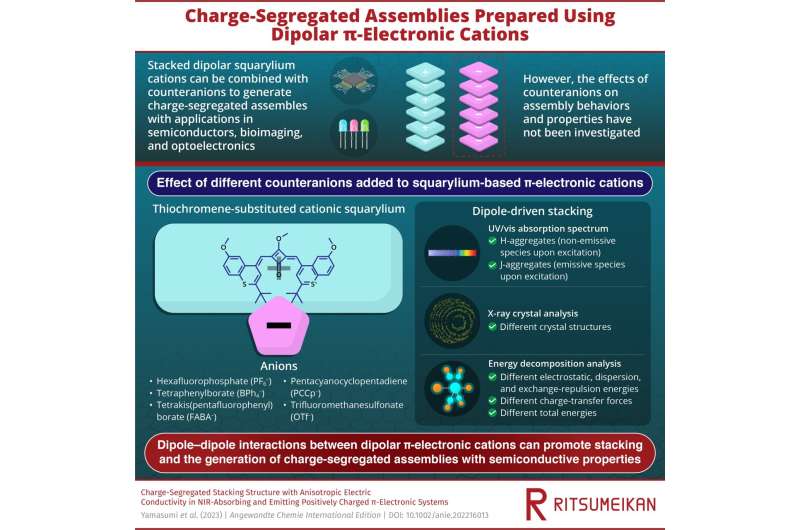This article has been reviewed according to Science X's editorial process and policies. Editors have highlighted the following attributes while ensuring the content's credibility:
fact-checked
peer-reviewed publication
proofread
Fine-tuning the properties of charge-segregated assemblies with counteranions

Scientists are constantly exploring new ways to design novel functional materials with tunable electronic properties. One promising area of research on this front is the use of π-electronic systems (systems in which the electrons occupy the p-orbitals of the atoms) to create stacked assemblies that, in turn, can be used to develop novel organic semiconductors.
By strategically arranging these systems, two types of assemblies can be generated: charge-by-charge assemblies consisting of alternately stacked oppositely charged species and charge-segregated assemblies comprising stacks of identically charged species.
While the former arrangement is relatively straightforward to generate due to electrostatic attraction between opposite charges, the latter, which have useful semiconductor properties, is challenging to construct as, in this case, the electrostatic repulsion between identically charged species must be overcome to create a stable structure.
One strategy for stacking identically charged species is to reduce the electrostatic repulsive forces through "dipole-dipole interactions." This has been achieved by incorporating alkyl groups into positively charged squarylium dyes, which leads to conformational changes and polarization states that decrease the electrostatic repulsion, facilitating the formation of stacked assemblies. Such positively stacked structures can be combined with various counterions to form charge-segregated assembles with tunable properties.
Now, in a study published in the journal Angewandte Chemie International Edition, researchers led by Professor Hiromitsu Maeda from Ritsumeikan University, Japan examined how counteranions added to stacked dipolar squarylium cations affect the assembly behaviors and properties.
"Charge-segregated assemblies are expected to be applied to organic semiconductors. The structural diversity in organic species as building blocks of assemblies will enable fine-tuning of the properties and additional functionality," says Prof. Maeda, explaining the motivation of their study.
To prepare a squarylium-based π-electronic cation, the researchers added methyl trifluoromethanesulfonate (CH3OTf) to a zwitterionic (dipolar ion-like) squarylium, generating an ion pair consisting of a thiochromene-substituted cationic squarylium (1a+) and trifluoromethanesulfonate anion (OTf-). This ion pair (1a+-OTf-) was then combined with different counteranions, namely hexafluorophosphate (PF6-), tetraphenylborate (BPh4-), tetrakis(pentafluorophenyl)borate (FABA-), and pentacyanocyclopentadiene (PCCp-), resulting in a diverse set of assemblies with the following π-electronic ion pairs: 1a+-PF6-, 1a+-BPh4-, 1a+-FABA-, and 1a+-PCCp-.
The team then examined the photophysical properties, crystal structures, and energy profiles of the generated assemblies. By studying their UV/visible absorption spectra in both poor and chiral solvents, they discovered that the properties of these ion pairs vary based on the counteranions.
Specifically, the ion pairs showed different absorption bands depending on the counterions, with some forming H-aggregates (non-emissive species upon excitation) and others forming J-aggregates (emissive species upon excitation). This suggested that the counteranions affected the modes of the assembled structures, altering the way these assemblies absorb light.
These structural changes were further confirmed using single-crystal X-ray analysis, which revealed different crystal structures for the different ion pairs. For instance, the interplanar distances were found to be different for each ion pair, leading to different orientations of the structure.
The changes in the structures were reflected in changes to the total energies of the systems. Using energy decomposition analysis, the researchers found that the distinct orientations of the ion-pairing assemblies resulted in different energies (electrostatic, dispersion, exchange-repulsion, charge-transfer forces) of the systems.
"The counteranion-dependent photophysical properties and electric conductivities were derived from assembly modes with direct contact of π-electronic cations," says Prof. Maeda.
Out of all the ion pairs, 1a+-PCCp– had a crystal structure and an energy profile that enabled a completely charge-segregated assembly. "It is noteworthy that a complete segregation of cations and anions was observed in a pseudo-polymorph of the ion pair with pentacyanocyclopentadienide as a π-electronic anion," says Prof. Maeda.
These findings pave the way for further research on the relationships between constituent ions and assembling modes, which could lead to the development of a wide variety of charge-segregated assemblies and functional materials.
Prof. Maeda concludes, "Dipolar charged π-electronic systems can be easily designed by slight modifications of various known charged π-electronic systems. The guideline proposed in our work will accelerate the development on this front, revealing their utility as semiconductors and other potential applications."
More information: Kazuhisa Yamasumi et al, Charge‐Segregated Stacking Structure with Anisotropic Electric Conductivity in NIR‐Absorbing and Emitting Positively Charged π‐Electronic Systems, Angewandte Chemie International Edition (2022). DOI: 10.1002/anie.202216013
Journal information: Angewandte Chemie International Edition
Provided by Ritsumeikan University



















